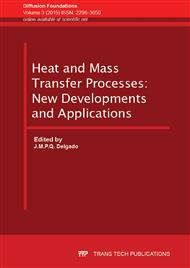[1]
EN 1348. Adhesives for tiles - Determination of tensile adhesion strength for cementitious adhesives. Brussels: European Committee for Standardization, (2007).
DOI: 10.3403/30153640
Google Scholar
[2]
EN 12004. Adhesives for tiles – Definitions and specifications. Brussels: European Committee for Standardization, (2008).
Google Scholar
[3]
Sá AV. Durability of Cementitious Adhesive in Ceramic Adherent Coverings of Walls. MSc. Thesis, Faculty of Engineering of the University of Porto, Portugal, 2005. (in Portuguese).
Google Scholar
[4]
Quintela MA. Durability of One-coat rendering mortar for external use. MSc. Thesis, Faculty of Engineering of the University of Porto, Portugal, 2006. (in Portuguese).
Google Scholar
[5]
Freitas VP, Corvacho H, Vaz Sá A, Quintela M. Discussing the durability assessment of cement mortars – a Contribution for a prediction model. Proceedings of the 11th International Conference on Durability of Building Materials and Components (DBMC-2008), Istanbul, Turkey 11-14 May, (2008).
Google Scholar
[6]
ISO 15686-1. Buildings and constructed assets – Service Life Planning – Part 1: General principles. Brussels: International Organization for Standardization, (2001).
Google Scholar
[7]
Freitas VP, Corvacho H, Quintela M, Delgado JMPQ. Assessing the Durability of Mortar Tiles - A Contribution for a Prediction Model. Engineering Failure Analysis 2014; 44: 36–45.
DOI: 10.1016/j.engfailanal.2014.04.027
Google Scholar
[8]
RILEM. Recommendation MDT D. 3. Determination in situ of the adhesive strength of rendering and plastering mortars to their substrate. Materials and Structures 200437: 488-490.
DOI: 10.1007/bf02481587
Google Scholar
[9]
Flores-Colen I, Brito J., Freitas VP. Expected render performance assessment based on impact resistance in situ determination. Construction and Building Materials 2009; 23(9): 2997-3004.
DOI: 10.1016/j.conbuildmat.2009.05.003
Google Scholar
[10]
Maranhão FL, Loh K, John VM. The influence of moisture on the deformability of cement–polymer adhesive mortar. Construction and Building Materials 2011; 25(6): 2948-2954.
DOI: 10.1016/j.conbuildmat.2010.12.004
Google Scholar
[11]
Ramos NMM, Simões ML, Delgado JMPQ, Freitas VP. Reliability of the pull-off test for in situ evaluation of adhesion strength. Construction and Building Materials 2012; 31(1): 86-93.
DOI: 10.1016/j.conbuildmat.2011.12.097
Google Scholar


